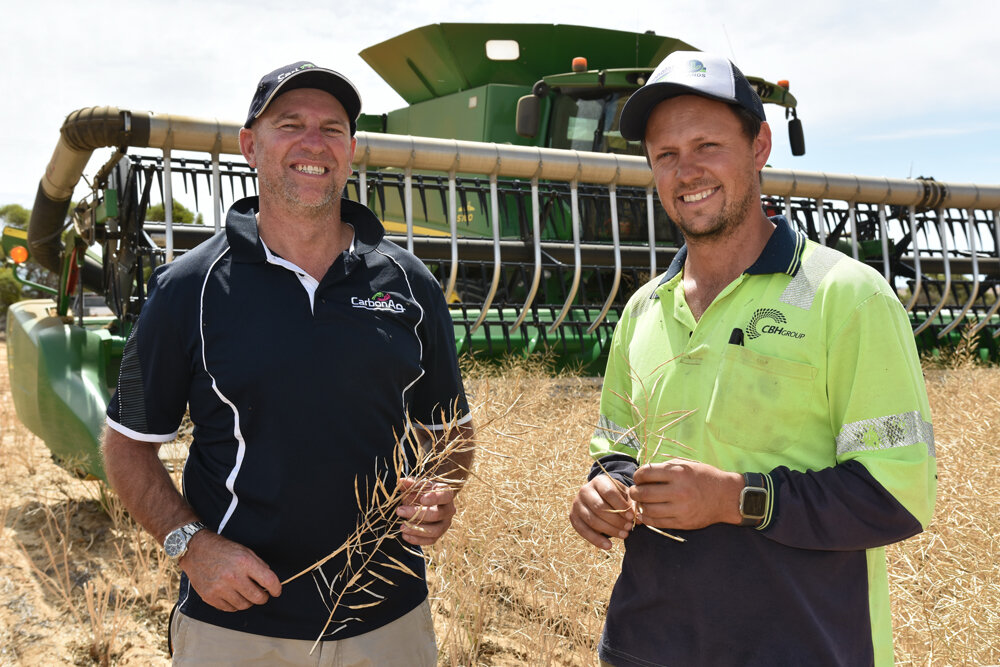Playing the soil amelioration game at Latham
DYLAN Hirsch knows soil amelioration for improved soil health is a long-term game and is keen to continue trialling carbon compost products, as well as high concentrate liquid fertilisers, on the sandy soils of his family’s Latham property.
The Hirschs used a deep ripper with inclusion plates to incorporate Carbon Ag’s WA Broadacre Blend loose compost at different rates into a canola trial area last season. In separate trials in wheat and lupins, they also drilled the company’s pelletised compost and applied DKP liquid fertiliser and Bioprime microbial stimulant at seeding followed by further foliar applications of DKP, Bioprime and CalMag liquid fertiliser.
The sites experienced challenging conditions, with a false break to the season causing some re-seeding to ensure consistency, followed by below average rainfall and a hail storm passing through the area.
“We will be looking at this as a long-term site. With soil amelioration, it’s a long-term thing and so it will be particularly interesting to see the second, third and fourth years,’’ Dylan said.
Latham grower Dylan Hirsch and Brad Wisewould, Carbon Ag, sample some of the company’s carbon-based ameliorant products.
Brad and Dylan discuss the suitability of the high concentrate liquid fertiliser, DKP, for the sandy soils on the Hirsch’s Latham property.
“We are really keen to see how Broadacre Blend works in amelioration. We have tried gypsum and lime and they work well on particular soil types. We will look at that with Broadacre Blend to work out where we get the best bang for our buck.
“For me, it’s about seeing what it’s doing and where its fit is. If we can get a 10 per cent increase, we can make this product worthwhile.’’
He said he believed there was more productivity to be gained with current farming systems.
“We still haven’t hit our potential. There’s plenty more we can learn about our soils and work out how to make them tick. Everyone wants to bring their farm up to their best paddock.’’
Despite the conditions, average plant weights recorded during the season were 250 grams where the traditional farm fertiliser program was applied, 600g where Broadacre Blend was applied alone and 850g where the compost and farm fertiliser was applied
Hail in the paddock reduced yields from 1.2t/ha to only 300 kilograms/ha, which compromised some of the trial assessment. There were no significant differences in yields across the treatments in the first season, however it will be monitored in subsequent years.
Brad Wisewould with Carbon Ag said despite the treatments in the trial, the company did not advocate applying WA Broadacre Blend without following compound fertilisers, but rather that growers take a balanced approach, applying the compost and fertilisers in the correct requirements according to target crop yields and season potential.
Soil carbon measurements at all sites after harvest in December using the Veris U3 soil mapping drive platform and ground-truthed by soil sampling proved interesting, with the carbon compost applications taking soil carbon levels from 0.3-0.4 up to 0.8 in some trial areas.
Dylan said soil carbon had been monitored for decades and previously not relied upon significantly as an indicator for soil health, but the industry also had not had a product or system to boost it until now.
He said Carbon Ag’s high concentrate DKP liquid fertiliser for use at seeding also was particularly interesting, compared with previous, low density phosphorus and potassium liquid products.
“What’s pleasing about DKP is the amount of P and K in the product – just how dense it is, and it could make seeding easier.’’
“Being able to place P and K closer to the seed is something we would always like to do, but you have got the risk of toxicity in a low rainfall environment. Having a product that we can apply right beside the seed without compromising plant establishment numbers – I think that could have a particular fit in certain situations and these sandy soils that are K deficient are one of those.
“Our sandy soils already have ultra-low levels of soil carbon and K, so they could show the most benefit. Cereals need P and K in the plants early, so DKP could have a good fit.’’
Dylan said he understood the liquid products and carbon compost pellet, as well as further foliar applications, could work well as a system, but, as a sceptical farmer, he also wanted to assess them individually.
He said it was pleasing to see Carbon Ag products in independent plot trials with COGGO.
“This is where we can start to see the differences – and really noticeable ones – on a statistically relevant level, which is good to back-up the paddock observations.’’
“The company is doing independent trials with independent ‘agros’ that are well documented and have sufficient data behind them. That’s the way forward and it’s pleasing that Carbon Ag is following that path,’’ Dylan said.


